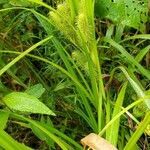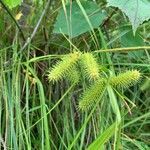Plants densely to loosely cespitose; rhizomes short, no more than 10 cm. Culms trigonous in cross section, 50–120 cm, scabrous distally. Leaves: basal sheaths pale brown; ligules usually much longer than wide; blades mid to dark green, flat to W-shaped, 5–16 mm wide, glabrous. Inflorescences 4–35 cm; proximal bract 15–85 cm, much longer than inflorescence; proximal (2–)3–6 spikes pistillate, erect or the proximal pendent, cylindric, 12–18 mm thick; terminal staminate or, sometimes, gynaecandrous, androgynous, or mixed. Pistillate scales lanceolate-acuminate, 2.8–12 × 0.4–1 mm, all but the proximal shorter than perigynia, margins ciliate, apex tapering to long scabrous awn. Staminate scales scabrous-awned, sometimes ciliate-margined. Perigynia spreading to reflexed when mature, strongly 14–22-veined, most veins separated by less than 2 times their width, confluent at or proximal to mid beak, tightly investing achene, narrowly elliptic to lanceolate, (4.8–)6.2–8.7 × 1.1–1.8 mm, leathery, apex gradually tapered; beak poorly defined, 2–3.8 mm, bidentate, teeth outcurved, 1.3–2.1(–2.8) mm. Stigmas 3. Achenes pale brown, trigonous, smooth.
More
Much like no. 200 [Carex hystericina Willd.]; stems stout; lowest bract surpassing and sometimes several times as long as the infl; terminal spike to 6 cm, staminate or sometimes androgynous or gynaecandrous or with the perigynia in the middle; pistillate spikes 2–7, loose and ± nodding on slender peduncles, tending to be rather closely grouped together; perigynia ± reflexed, firm-textured and only slightly or scarcely inflated, obtusely trigonous, tapering to a short-stipitate base, and very gradually tapering above to the long beak with slender, firm, arcuate or divergent teeth 1.2–2.3 mm; mature style straight or seldom flexuous or contorted. Swamps and wet meadows; Que. to Minn., s. to Fla. and La.; Wash. to Calif. and n. Ida.









